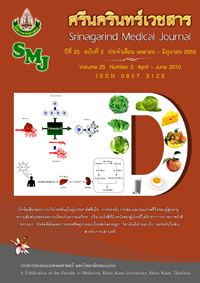Factors Related to Anesthetic Equipment Loss at Srinagarind Hospital, Khon Kaen University
Abstract
Background and Objective: During anesthesia and the post-operative period, standard equipment and monitoring are essential. Srinagarind hospital has over one thousand items of equipment for its 20 operating rooms and 2 post-anesthesia care units (PACU). Based on a survey between October 2007 and September 2008, it was discovered that 18 items of anesthetic equipment went missing, worth between 30,000 and 40,000 Baht. The objectives of this study were to identify the factors related to equipment loss and to find strategies to prevent or mitigate losses.
Methods : We conducted qualitation research, using basic data regarding equipment losses derived from a problem-solving fishbone diagram that emerged during a departmental seminar in November 2008. Our responsive study ran between March and August 2009. The department provided the anesthetic equipment in all of the operating rooms and PACUs with checklist logs. When equipment went missing, researchers invited related personnel to discuss the loss and to find strategies for prevention (focus group discussion). The summary of the data collected and response protocols were later presented at a departmental conference.
Results : The focus group discussions during study period involved 150 personnel, comprising anesthesia personnel (60/150, 40%), operating room personnel (30/150, 20%), intensive care personnel (20/150, 13.3%) and laundry personnel (40/150, 26.7%). The study revealed that the intradepartmental factors related to equipment loss were personnel, work pattern, management, time of work, the involved equipment and the budget. But extradepartmental factors had specific differences depend on personnel groups. The process resulted in four intradepartmental preventive guidelines and some activities within and outside the department.
Conclusions : The factors related to anesthetic equipment loss involved both within and outside the department. Preventive guidelines have been established, including some activities both within and outside the department.
Keywords : Anesthetic Equipment Loss � sp� �=� d that the entrance skin dose found in skin patients. Set of techniques for patients irradiated for chest radiography. The results revealed that the mean and the third quartile (75th percentile) dose were 0.2 and 0.23 mGy, respectively, which fairly smaller than the dose IAEA standard reference and other research.Conclusion: The average skin dose patients received in the general chest X-ray imaging. Compared with the reference dose level research found that dose levels lower than any research. Study the radiation dose to the skin of patients received radiation from common imaging method can be measured easily and conveniently. We supposed this study can be adjusted to configure the imaging techniques for recievering less radiation used as a guide to study the dose patients receive from other general imaging radiation, such as general abdominal imaging or spinal imaging.
Keywords: Entrance skin dose




